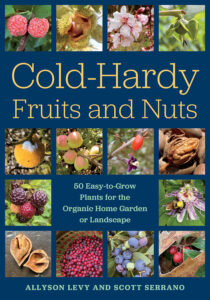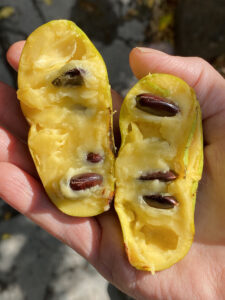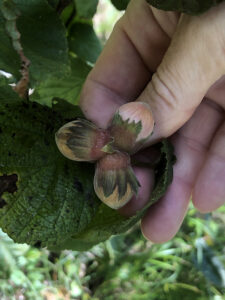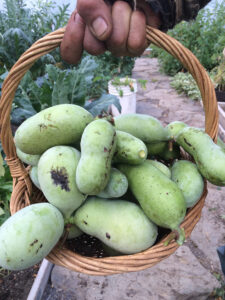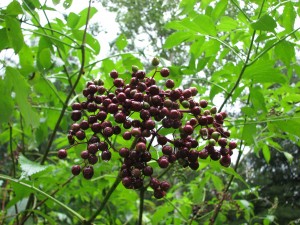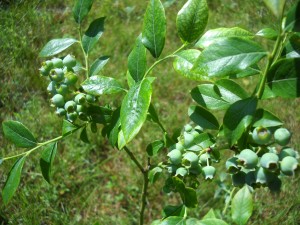Growing Nuts and Berries
I recently was sent a review copy of a wonderful book by Allyson Levy and Scott Serranno: Cold-Hardy Fruits and Nuts: 50 Easy-to-Grow Plants for the Organic Home Garden or Landscape printed by Chelsea Green Publishing (all photos supplied by the authors). When I got it I could barely pull myself away from it because it has so much to teach me.
I asked them what they would recommend for fruit if someone had none, and wanted to start with winners. Scott suggested blueberries and blackberries. Both are easy and tasty. Elderberries are good, too, they said, although you need to cook the berries to make them palatable. Elderberries, honey and lemon juice make a nice syrup which I use to help prevent colds in winter.
Of the nuts, they recommend hazelnuts. These produce nuts as much younger plants than things like black walnut or pecans which are tall trees that require years to produce nuts. You need to have two or more hazelnuts as they are not self-fertile. Scott pointed out that the native species has smaller nuts than some of the named varieties.
The Hortus Arboretum and Garden is open from Mother’s Day in May until the end of October, Friday to Sunday. Admission is by donation. Because of Covid, they have been scheduling visitors on-line during the season at their website, www.Hortusgardens.org.
Berries
By now my vegetable gardens is all planted, annual flowers are in, the weeds are pretty much under control. Time to relax and smell the roses? Well, maybe not. There are always tasks for the gardener. This is a good time to plant some berry bushes.
The first thing to do, if you want a good berry patch, is to test the soil to find out if you need to add specific nutrients. Go to your university extension Web site, or Google “soil testing”. You should be able to download a form and get instructions on how to collect a soil sample, and where to send it. All berry patches will also need some added organic matter such as compost, aged manure, or leaf mold.
Competition from weeds is an important issue for berries. You can’t just use a rototiller to chew up a patch of field or lawn to plant your berries. You really need to dig out the sod – or smother it this year to plant next year. A layer of 4-mil black plastic spread out over a lawn that has been cut short will kill the grass, roots and all, by the end of the summer. Landscape fabric will do the same, but is more expensive. Next spring the dead grass will add organic matter when you mix it in.
If you want to plant this year you have two choices: dig out the sod by hand, or rent a sod lifter – I reject the idea of using chemicals to nuke the grass. The sod lifter is powered by a gas engine; it sends a blade under the sod and along the edges to slice it loose. You still have to pick up the sod and lug it away. And you can’t roll it up like a rug – it’s too heavy. I slice the long strip of sod into 1- or 2-foot sections. Or, for small areas, you can just use a shovel to slice sod into one foot squares to pry out by hand, which is very labor intensive. Ugh.
All berries like sunshine. Six hours per day is the minimum for a good crop. More is always better. Berries do not like root competition, so keep your berry patch away from trees. I planted a rose recently that was more than 50 feet from a Norway maple, and found the soil full of tree roots coming from the maple. So pick a site far from trees if possible.
Raspberries are a great choice for the home gardener: they are expensive at the store and do not keep well. Better to grow your own and eat some every day in season. What are the best varieties? I asked Alicia Jenks, the owner of Green Dragon Farm, a pick-your-own blueberry and raspberry farm in Weathersfield, Vermont. She suggested getting ‘Prelude’ or ‘Killarney’ for an early crop. Then ‘Encore’ or ‘Latham’ for mid-season berries and ‘Heritage’ for late-season berries.
Alicia Jenks suggested planting raspberries 3 feet apart in a staggered double row in a 5 or 6-foot wide bed. Add plenty of compost to the soil and work it in well – a 4-inch layer is a good. She adds Pro-Gro, an organic, slow-release fertilizer to the soil at planting time in each hole. Although you can buy bare root plants early in the spring, most sellers of them are sold out by now. Potted bushes are still readily available at garden centers.
Blueberries are another good choice for every home gardener. The soil requirements for blueberries are very different than for raspberries, however. Paul Franklin of Riverview Farm, a pick-your-own apple, pumpkin
and berry farm in Plainfield, NH, told me that there are just three important things to get right in order to have a good crop: proper pH, proper pH and proper pH. He went on to explain that the soil must be very acidic in order to get a good crop – in the range of 4.0 to 5.5. So get your soil tested and add a soil acidifier such as elemental sulfur to get the soil pH right. Pro-Holly or Holly-Tone (organic acidic fertilizers) are good for blueberries, too, and can be added around existing bushes now.
Blueberries should be spaced about 5 feet apart in rows that are far enough apart to allow mowing. Most commercial growers mulch with woodchips to keep down weeds. The roots grow close to the surface, so you can’t dig out weeds willy-nilly – you may damage roots. So get grasses and weeds out in a 5-foot circle before you plant, and mulch well to keep them out. Weeds will steal the water and nutrients your blueberries need.
Elderberries are an easy crop if you have a moist location on your property. I grow 3 varieties on the bank of a little stream, and they do well. Pollination is better if you have 2 or more different varieties. The white, fragrant flowers form big clusters at the top of the bushes and are decorative right now. In the late summer I harvest elderberries by sniping off clusters of berries; later, in the house, I pull the berries off their stems and freeze them. I like to sprinkle them on hot oatmeal in winter and I also make an elderberry syrup to ward off colds.
So go plant some berries, or more berries, or different kinds of berries. You’ll be glad you did.
Henry Homeyer is a gardening consultant and Master Gardener living in Cornish Flat, NH. Contact him at henry.homeyer@comcast.net. His Web site is www.Gardening-Guy.com.



